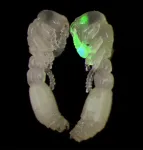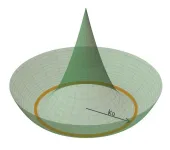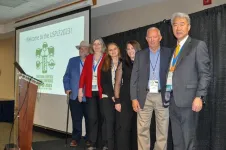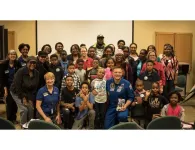(Press-News.org) Despite some of the most successful international vaccination campaigns in history, the poliovirus continues to circulate around the world, posing a threat of neurological damage and even paralysis to anyone who is not vaccinated.
While the original polio strains, called wildtype, have largely been eliminated, new strains can develop from the oral polio vaccine (OPV), which is the one most used in the developing world. Oral vaccines use live, weakened virus that occasionally mutates to an active form, leading to outbreaks even in countries believed to have eliminated polio.
Scientists at UCSF and the UK’s National Institute of Biological Standards and Control (NIBSC) have developed two novel oral polio vaccines (nOPVs) to bolster the World Health Organization’s most recent push to finally eradicate polio, which began two years ago using the first nOPV developed by the same team. These are the first new polio vaccines in 50 years.
Like the first nOPV, the two newest nOPVs, which were described in Nature on June 14, are made from weakened poliovirus that has been genetically engineered to reduce reversion to dangerous forms of the virus. The development of these new vaccines was led jointly by Raul Andino, PhD, UCSF professor of microbiology and immunology, and Andrew Macadam, PhD, a virologist at NIBSC.
“With such variation in vaccination within and between countries, poliovirus has persisted into the 21st century, with sometimes tragic consequences,” said Andino, co-senior author of the paper along with Macadam. “We’ve designed these new vaccines using lessons learned from many years of fighting polio and believe they will help eliminate the disease once and for all.”
The evolving battle against polio
Polio is insidious: it is usually asymptomatic, but can cause severe disability, paralysis or death in about one in every hundred children. It spreads via fecal or oral particles, so it is particularly problematic in regions with poor sanitation. In the first half of the 20th century, polio outbreaks routinely rolled through the US, leading to a race to develop vaccines.
The first effective polio vaccines emerged in the 1950s, kicking off massive campaigns to immunize every person, with an emphasis on children. The inactivated polio vaccine (IPV), made of dead poliovirus, was given via injection, while the oral polio vaccine (OPV), made of weakened poliovirus, was given on a sugar cube or in a candy. Today, IPV is the vaccine of choice in countries with robust healthcare, and OPV – the cheaper, easier-to-administer option – is used otherwise.
In populations where everyone is immunized early in life, it doesn’t matter whether they receive IPV or OPV, although these vaccines act in different ways in the environment. People vaccinated with IPV can still get infected with any polio that happens to be circulating. They will not get sick, but they can silently transmit the virus to the unvaccinated. People vaccinated with OPV can’t silently transmit circulating polio in this way, but they can shed the weakened virus they were inoculated with and spread it to the unvaccinated. If the weakened virus mutates, it can become pathogenic polio once more.
In populations with unvaccinated children – whether due to refusal to vaccinate, natural disaster, or war – such vaccine-derived polio can spread widely, causing severe disease in the unlucky few.
While the original, or “wildtype,” poliovirus has only been recently detected in Afghanistan and Pakistan, vaccine-derived polio has been detected in countries as far flung as Syria, the Democratic Republic of Congo, and the U.S. In fact, there have been more cases of vaccine-derived polio than wildtype in recent years, creating an urgency to counter this new source of polio.
In 2017, Andino and his colleagues discovered how OPV reverts to its harmful form: a single mutation restores the virus’s capacity to migrate from the human gut and into the nervous system. Within a few years, the group had devised a trio of mutations that make such genetic reversion much less likely and packaged it into a new vaccine.
That vaccine, nOPV2, earned the WHO’s first-ever emergency use listing for a vaccine in 2020 and was quickly manufactured and distributed.
“Over 600 million doses were delivered to more than 28 countries, and in ten instances it stopped ongoing outbreaks of vaccine-derived polio,” said Andino. “It gave us a lot more confidence that this actually was working as anticipated.”
Covering all the bases with polio eradication
Despite its effectiveness, nOPV2 only protects against one of three strains of polio, and cases of polio have recently emerged in Israel, which is heavily vaccinated, as well as in pockets of the US where people refuse to vaccinate their kids.
Even where there are no polio cases in hospitals, polio continues to be detected in wastewater in major cities. There may be 99% fewer polio cases today than there were 30 years ago, but the last 1% has proven hard to snuff out.
“If there’s polio anywhere, it will come back where there are gaps in vaccination,” Andino said.
The latest work from Andino’s group takes the solution they crafted for nOPV2 – the three mutations that usually prevent the vaccine from becoming dangerous over time – and engineers it into the other two types of OPV. The resulting vaccines, nOPV1 and nOPV3, effectively prevented polio in animal models. All three are much safer than the original OPVs, which can occasionally cause paralysis in those who get the vaccine, although this is rare (on the order of one case per two million children vaccinated).
The two new vaccines are currently being tested in clinical trials to ensure that they are both effective and do not revert to dangerous forms in humans. Andino is hopeful they will be incorporated into bivalent or trivalent combinations with nOPV2. Children of the future will be equally protected from polio for life, and perhaps the world will someday experience decades in which zero polio is detected.
“The perception that polio is gone is a dangerous one,” said Andino. “For instance, just in India, 500,000 children are born each week, an enormous number of susceptible people. We now have what we need to protect them.”
Authors: One other UCSF researcher is Ming Te Yeh. Additional authors can be found in the paper.
Funding: This work was supported in part by funding from the NIH (R01 AI36178, AI40085, P01 AI091575) and the Bill and Melinda Gates Foundation (OPP1150001 and OPP1099295).
Disclosures: None.
About UCSF: The University of California, San Francisco (UCSF) is exclusively focused on the health sciences and is dedicated to promoting health worldwide through advanced biomedical research, graduate-level education in the life sciences and health professions, and excellence in patient care. UCSF Health, which serves as UCSF's primary academic medical center, includes top-ranked speciality hospitals and other clinical programs, and has affiliations throughout the Bay Area. UCSF School of Medicine also has a regional campus in Fresno. Learn more at https://ucsf.edu, or see our Fact Sheet.
###
Follow UCSF
ucsf.edu | Facebook.com/ucsf | YouTube.com/ucsf
END
Building a new vaccine arsenal to eradicate polio
2023-06-14
ELSE PRESS RELEASES FROM THIS DATE:
Food allergy is highest among Hispanic, Black and Asian individuals
2023-06-14
· Many racial and ethnic groups not well aware of food allergies
· Lack of food allergy research in racial and ethnic communities
· ‘These individuals need to be aware so they can be diagnosed and treated’
CHICAGO --- Food allergy has not been on the radar of most racial and ethnic communities. But a new Northwestern Medicine study — the first population-based food allergy study in the U.S. to explore racial and ethnic differences in all age groups — shows why it should be.
The new study found the prevalence of food allergy is highest among Hispanic, non-Hispanic Black and ...
World’s first transgenic ants reveal how colonies respond to an alarm
2023-06-14
Ants navigate their richly aromatic world using an array of odor receptors and chemical signals called pheromones. Whether foraging or defending the nest, mating or tending to their young, ants both send and receive chemical signals throughout their lives. The importance of this system is underscored by how well equipped the ant brain is to process the abundance of scents: The olfactory processing center in the ant’s brain has 10 times as many subdivisions as fruit flies do, for example, even though their brains are about the same size.
And yet how the ant olfactory system encodes scent data has remained largely unknown. To whittle ...
For experimental physicists, quantum frustration leads to fundamental discovery
2023-06-14
AMHERST, Mass. – A team of physicists, including University of Massachusetts assistant professor Tigran Sedrakyan, recently announced in the journal Nature that they have discovered a new phase of matter. Called the “chiral bose-liquid state,” the discovery opens a new path in the age-old effort to understand the nature of the physical world.
Under everyday conditions, matter can be a solid, liquid or gas. But once you venture beyond the everyday—into temperatures approaching absolute zero, things smaller than a fraction ...
Metamaterials with built-in frustration have mechanical memory
2023-06-14
Researchers from the UvA Institute of Physics and ENS de Lyon have discovered how to design materials that necessarily have a point or line where the material doesn’t deform under stress, and that even remember how they have been poked or squeezed in the past. These results could be used in robotics and mechanical computers, while similar design principles could be used in quantum computers.
The outcome is a breakthrough in the field of metamaterials: designer materials whose responses are determined by their structure rather than their chemical composition. To construct a metamaterial with mechanical memory, physicists ...
Earth was created much faster than we thought. This makes the chance of finding other habitable planets in the Universe more likely
2023-06-14
When we walk around in our everyday life, we might not think of the Earth itself very often. But this planet is the foundation of our life. The air we breathe, the water we drink and the gravity that pins us to the ground.
Up until now, researchers believed that it took more than 100 million years for the Earth to form. And it was also common belief that water was delivered by lucky collisions with water-rich asteroids like comets.
However, a new study from the University of Copenhagen suggests that it might not have happened entirely by chance.
“We show that the Earth formed by the very ...
A scorching-hot exoplanet scrutinized by UdeM astronomers
2023-06-14
An international team led by Stefan Pelletier, a Ph.D. student at Université de Montréal's Trottier Institute for Research on Exoplanets announced today having made a detailed study of the extremely hot giant exoplanet WASP-76 b.
Using the MAROON-X instrument on the Gemini-North Telescope, the team was able to identify and measure the abundance of 11 chemical elements in the atmosphere of the planet.
Those include rock-forming elements whose abundances are not even known for giant planets in the Solar System such as Jupiter or Saturn. The team's study is published in ...
A growing number of producers and industries interested in precision livestock farming
2023-06-14
Some of the world’s best minds that are focused on profitable and sustainable livestock production attended and presented at the recent Second U.S. Precision Livestock Farming Conference. Hosted by University of Tennessee AgResearch, the May 21-24 event at the UT Conference Center in Knoxville attracted 219 attendees representing 22 countries and 32 U.S. states. Participants included academics, representatives of government agencies and allied industries as well as producers. The conference had a central theme of “Field Application of PLF Technologies” and academic presentations along with two industry and producer panels included interactive dialogues among the attendees ...
It takes a village: Study shows community is key to a sustained passion for science among adolescents
2023-06-14
The results of a yearlong science program show that one of the best ways to instill a lasting interest in science among children is to engage them alongside their family members. This finding runs counter to the current framework, in which children attend science-related summer camps and after-school programs apart from their families, diminishing the long-term potential of what they learn.
“We wanted to see if we could support families as a whole, as opposed to giving a student a really amazing one-off experience and sending them ...
Racial disparities found in one of first studies of pharmacological treatment of insomnia
2023-06-14
INDIANAPOLIS — In one of the first studies to investigate racial disparities in the pharmacologic treatment of insomnia, researchers from Regenstrief Institute and Indiana University report that patients belonging to racial minority groups were significantly less likely to be prescribed medication following diagnosis of insomnia than White patients.
The study found that Black patients were much less likely to have been prescribed an FDA-approved insomnia medication at any time post diagnosis than White patients. Other non-White individuals were significantly less likely to be prescribed an FDA-approved medication two, three, and four years after insomnia diagnosis ...
New York Academy of Sciences, Leon Levy Foundation name first 10 Leon Levy Scholars in Neuroscience
2023-06-14
New York, NY, June 14, 2023 — The New York Academy of Sciences and the Leon Levy Foundation announced today the first cohort of Leon Levy Scholars in Neuroscience; a continuation of an earlier fellowship program started by the Foundation in 2009 that has supported 160 fellows in neuroscience.
This highly regarded postdoctoral program supports exceptional young researchers across the five boroughs of New York City as they pursue innovative investigations in neuroscience and advance in their careers toward becoming independent principal investigators. Designed to broaden the field and to support researchers who might otherwise not ...





